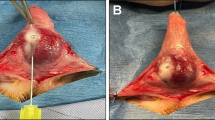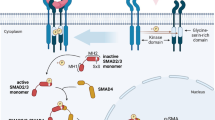Abstract
Peyronie's disease (PD) is characterized by fibrotic plaques in the penile tunica albuginea that cause curvature of the erect penis, and is often accompanied by pain and/or erectile dysfunction. This condition affects up to 9% of men. Treatment is mainly surgical, as pharmacologic therapy has limited efficacy. The pathophysiology of PD is poorly understood, but development of two rat models, extrapolation of what is known about the molecular pathology of other fibrotic conditions, and emphasis on the role of myofibroblasts and adult stem cells are helping to clarify etiology and identify new pharmacologic targets. Recent studies demonstrate a role for oxidative stress and cytokine release—primarily transforming-growth-factor β1—in development of PD fibrotic plaques. There is evidence indicating that these profibrotic factors interact with antifibrotic defense mechanisms, such as decrease of myofibroblast accumulation, elimination of reactive oxygen species by inducible nitric oxide synthase and neutralization of transforming-growth-factor β1 by decorin, such that some plaques are in dynamic turnover. Injury to the erect penis is thought to trigger PD by inducing extravasation of fibrin and subsequent synthesis of transforming-growth-factor β1. Despite the lack of statistical support for a causal association between trauma and PD, it is possible that undetected microtrauma is involved. It is not known whether ossification of PD plaques is linked to fibrosis progression or is a manifestation of an alternative pathway. Both processes seem to be related to activation of fibroblast/myofibroblast differentiation in the tunica albuginea and to osteogenic commitment of stem cells in this tissue.
This is a preview of subscription content, access via your institution
Access options
Subscribe to this journal
Receive 12 print issues and online access
$209.00 per year
only $17.42 per issue
Buy this article
- Purchase on Springer Link
- Instant access to full article PDF
Prices may be subject to local taxes which are calculated during checkout


Similar content being viewed by others
References
Schwarzer U et al. (2001) The prevalence of Peyronie's disease: results of a large survey. BJU Int 88: 727–730
Mulhall JP et al. (2004) Subjective and objective analysis of the prevalence of Peyronie's disease in a population of men presenting for prostate cancer screening. J Urol 171 (Pt 1): 2350–2353
Usta MF et al. (2004) Relationship between the severity of penile curvature and the presence of comorbidities in men with Peyronie's disease. J Urol 171: 775–779
Carrieri MP et al. (1988) A case-control study on risk factors for Peyronie's disease. J Clin Epidemiol 51: 511–515
Usta MF et al. (2004) Stratification of penile vascular pathologies in patients with Peyronie's disease and in men with erectile dysfunction according to age: a comparative study. J Urol 172: 259–262
Levine LA (2003) Review of current nonsurgical management of Peyronie's disease. Int J Impot Res 15 (Suppl 5): S113–S120
Gonzalez-Cadavid NF and Rajfer J (2004) Molecular and cellular aspects of the pathophysiology of Peyronie's disease. Drug Discov Today 1: 99–104
El-Sakka AI et al. (1997) An animal model of Peyronie's-like condition associated with an increase of transforming growth factor beta mRNA and protein expression. J Urol 158: 2284–2290
El-Sakka AI et al. (1998) Histological and ultrastructural alterations in an animal model of Peyronie's disease. Br J Urol 81: 445–452
Intengan HD and Schiffrin EL (2001) Vascular remodeling in hypertension: roles of apoptosis, inflammation, and fibrosis. Hypertension 38: 581–587
Becker GJ et al. (2001) Pharmacological intervention in renal fibrosis and vascular sclerosis. J Nephrol 14: 332–339
Gholami SS et al. (2003) Peyronie's disease: a review. J Urol 169: 234–241
Gabbiani G (2003) The myofibroblast in wound healing and fibrocontractive diseases. J Pathol 200: 500–503
Li Y and Huard J (2002) Differentiation of muscle-derived cells into myofibroblasts in injured skeletal muscle. Am J Pathol 161: 895–907
Mulhall JP (2003) Expanding the paradigm for plaque development in Peyronie's disease. Int J Impot Res 15 (Suppl 5): S93–S102
Gonzalez-Cadavid NF et al. (2002) Gene expression in Peyronie's disease. Int J Impot Res 14: 361–374
Devine CJ Jr et al. (1997) Proposal: trauma as the cause of the Peyronie's lesion. J Urol 157: 285–290
Gong R et al. (2003) Hepatocyte growth factor modulates matrix metalloproteinases and plasminogen activator/plasmin proteolytic pathways in progressive renal interstitial fibrosis. J Am Soc Nephrol 14: 3047–3060
Ehrlich HP (1997) Scar contracture: cellular and connective tissue aspects in Peyronie's disease. J Urol 57: 316–319
Davila HH et al. (2003) Fibrin as an inducer of fibrosis in the tunica albuginea of the rat: a new animal model of Peyronie's disease. BJU Int 91: 830–838
Somers KD and Dawson DM (1997) Fibrin deposition in Peyronie's disease plaque. J Urol 157: 311–315
Davila HH et al. (2004) Gene transfer of inducible nitric oxide synthase complementary DNA regresses the fibrotic plaque in an animal model of Peyronie's disease. Biol Reprod 71: 1568–1577
Davila H et al. (2005) Peyronie's disease is associated with an increase of plasminogen activator inhibitor-1 (PAI-1) at the RNA and protein levels. Urology 65: 645–648
Kim JJ et al. (2004) Novel animal model of Peyronie's disease by tunical injection of autologous blood. In Proceedings of the International Society for Sexual and Impotence Research Meeting: 2004 October 17–21; Buenos Aires, Argentina
Zargooshi J (2004) Trauma as the cause of Peyronie's disease: penile fracture as a model of trauma. J Urol 172: 186–188
Clarkson PM and Hubal MJ (2002) Exercise-induced muscle damage in humans. Am J Phys Med Rehabil 81 (Suppl): S52–S69
King JB (1998) Post-traumatic ectopic calcification in the muscles of athletes: a review. Br J Sports Med 32: 287–290
Bivalacqua TJ et al. (2002) Implications of nitric oxide synthase isoforms in the pathophysiology of Peyronie's disease. Int J Impot Res 14: 345–352
Sikka SC and Hellstrom WJ (2002) Role of oxidative stress and antioxidants in Peyronie's disease. Int J Impot Res 14: 353–360
Ferrini MG et al. (2002) Antifibrotic role of inducible nitric oxide synthase. Nitric Oxide 6: 283–294
Vernet D et al. (2002) Effect of nitric oxide on the differentiation of fibroblasts into myofibroblasts in the Peyronie's fibrotic plaque and in its rat model. Nitric Oxide 7: 262–276
Valente EG et al. (2003) PDE L-arginine and PDE inhibitors counteract fibrosis in the Peyronie's fibrotic plaque and related fibroblast cultures. Nitric Oxide 9: 229–244
El-Sakka AI et al. (1999) The effects of colchicine on a Peyronie's-like condition in an animal model. J Urol 161: 1980–1983
Quan TE et al. (2004) Circulating fibrocytes: collagen-secreting cells of the peripheral blood. Int J Biochem Cell Biol 36: 598–606
Gonzalez-Cadavid NF and Rajfer J (2004) Therapy of erectile function: potential future treatments. Endocrine 23: 167–176
Ferrini M et al. (2001) Aging-related expression of inducible nitric oxide synthase (iNOS) and markers of tissue damage in the rat penis. Biol Reprod 64: 974–982
Ferrini MG et al. (2004) Aging-related induction of inducible nitric oxide synthase (iNOS) is vasculo-protective in the arterial media. Cardiovascular Res 61: 796–805
Kovanecz I et al. (2005) Pioglitazone ameliorates penile corpora veno-occlusive dysfunction (CVOD) in a rat model of type 2 diabetes [abstract # 1045]. In Proceedings of the 100th American Urological Association Annual Meeting: 2005 May 21ndash;26; San Antonio, Texas
Qian A et al. (2004) Comparison of gene expression profiles between Peyronie's disease and Dupuytren's contracture. Urology 64: 399–404
Tomasek JJ et al. (1999) Cellular structure and biology of Dupuytren's disease. Hand Clin 15: 21–34
O'Brien K et al. (2004) Analysis of the natural history of Peyronie's disease. In Proceedings of the International Society for Sexual and Impotence Research Meeting: 2004 October 17–21; Buenos Aires, Argentina
Vernet D et al. Evidence that osteogenic progenitor cells in the human tunica albuginea may originate from stem cells. Implications for Peyronies disease. Biol Reprod, in press
Gelbard MK (1988) Dystrophic penile calcification in Peyronie's disease. J Urol 139: 738–740
Andresen R et al. (1996) Ultrasound and soft-tissue radiography to monitor local interferon-alpha 2B treatment in Peyronie's disease. Acta Radiol 37: 352–356
Hauck EW et al. (2003) Diagnostic value of magnetic resonance imaging in Peyronie's disease—a comparison both with palpation and ultrasound in the evaluation of plaque formation. Eur Urol 43: 293–299
Davis CJ Jr (1997) The microscopic pathology of Peyronie's disease. J Urol 157: 282–284
Mulhall JP et al. (2004) Chromosomal instability is demonstrated by fibroblasts derived from the tunica of men with Peyronie's disease. Int J Impot Res 16: 288–293
Mulhall JP et al. (2001) Perturbation of cell cycle regulators in Peyronie's disease. Int J Impot Res 13 (Suppl 5): S21–S28
Mulhall JP et al. (2004) Peyronie's disease fibroblasts demonstrate tumorigenicity in the severe combined immunodeficient (SCID) mouse model. Int J Impot Res 16: 99–104
Schurch W (1999) The myofibroblast in neoplasia. Curr Top Pathol 93: 135–148
Acknowledgements
Experimental studies of the authors were funded by grants from the Eli and Edythe L Broad Foundation and NIH R01DK-53069, and partially by NIH Program grants G12RR-03026, and 5P20MD000545.
Author information
Authors and Affiliations
Corresponding author
Ethics declarations
Competing interests
The authors declare no competing financial interests.
Glossary
- PENILE TUNICA ALBUGINEA
-
Dense white fibroelastic sheath enclosing the penile corpora cavernosa, lacunar smooth muscle and endothelium
- DUPUYTREN'S DISEASE
-
A disease characterized by progressive thickening and contracture of fibrous tissue of the hand and fingers
- MYOFIBROBLASTS
-
Differentiate from fibroblasts or stem cells; contain contractile arrays of smooth-muscle proteins (actin) that confer smooth-muscle-like phenotype; key cell in wound healing and fibrosis
- PLASMINOGEN ACTIVATOR INHIBITOR 1 (PAI-1)
-
Inhibits activation of serine-protease-mediated conversion of plasminogen to plasmin, involved in clot lysis and tissue remodeling during wound healing; also inhibits metalloproteinases involved in collagen breakdown
- SCLERODERMA
-
Skin progressively tightens and thickens due to deposition of fibrous connective tissue; internal organs can also be affected
- SPINDLE
-
A microtubular array that regulates the distribution of chromosomes during meiosis and mitosis
- PHOSPHODIESTERASE-5 (PDE5) INHIBITOR
-
An agent (sildenafil, vardenafil, tadalafil, and others) that inhibits PDE5, thus preventing breakdown of cGMP produced by activation of guanylyl cyclase by nitric oxide and other processes
- PLEIOTROPIC
-
Producing multiple effects; that is, a single agent acting on several different processes
- WESTERN BLOT
-
Proteins are fractionated by size on a gel, transferred to a membrane and immobilized to preserve their spatial arrangement; target proteins are identified by binding of specific antibodies and visualized by detection of colorimetric, autoradiographic, or chemiluminescent labels
- REVERSE TRANSCRIPTION POLYMERASE CHAIN REACTION (RT-PCR)
-
Reverse transcriptase-catalyzed in vitro synthesis of a specific DNA fragment from an RNA template followed by generation of a large number of copies of the DNA
- CD34
-
A 110kDa monomeric cell-surface antigen selectively expressed on human hematopoietic progenitor cells and other types of stem cells
- ANEUSOMIES
-
Abnormal chromosome numbers; that is, too few or too many of one or more chromosomes in the nucleus
- FLOW CYTOMETRY
-
Cells are sorted by size as they pass through a laser beam; those harboring an antigen of interest can be detected and counted by binding of an antibody conjugated to a fluorescent tag
- S-PHASE
-
DNA is replicated during this phase of the cell cycle
- TP53
-
Gene encoding a 53kDa tumor-suppressor protein; abnormalities of p53 are frequently detected in human tumors
Rights and permissions
About this article
Cite this article
Gonzalez-Cadavid, N., Rajfer, J. Mechanisms of Disease: new insights into the cellular and molecular pathology of Peyronie's disease. Nat Rev Urol 2, 291–297 (2005). https://doi.org/10.1038/ncpuro0201
Received:
Accepted:
Issue Date:
DOI: https://doi.org/10.1038/ncpuro0201
This article is cited by
-
Which inflammatory marker, between systemic immune-inflammation index and neutrophil to eosinophil ratio, is associated with Peyronie’s disease and are there any implications for a better understanding of its mechanisms?
Basic and Clinical Andrology (2023)
-
A systematic review of non-surgical management in Peyronieʼs disease
International Journal of Impotence Research (2023)
-
Characterization of a novel rabbit model of Peyronie’s disease
International Journal of Impotence Research (2023)
-
Use of penile shear wave elastosonography for the diagnosis of Peyronie’s Disease: a prospective case–control study
Basic and Clinical Andrology (2022)
-
Anti-fibrotic effect of mycophenolate mofetil on Peyronie’s disease experimentally induced with TGF-β
International Journal of Impotence Research (2020)



